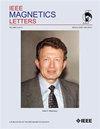利用磁性纳米粒子链模板在树脂中形成单向孔
IF 1.1
4区 物理与天体物理
Q4 ENGINEERING, ELECTRICAL & ELECTRONIC
引用次数: 0
摘要
我们提出了一种新的制造技术,使用具有链状结构的自组装磁性纳米颗粒(MNP)在紫外线(UV)固化树脂中产生单向孔。该方法利用两种模板形成孔的机制:MNP链的UV掩蔽效应和MNP链本身的物理存在。分别以Fe3O4纳米粒子和PAK-01为模板和紫外光固化树脂。只有当树脂/MNP混合物在强外加磁场下固化时才形成单向孔。吸水性试验表明,部分单向孔隙为通孔型孔隙。孔隙为圆柱形,横截面为椭圆形。当紫外线照射角(θ)为30°时,在去除MNP之前,孔的长径和短径分别约为9和8$\mu$m,在去除之后,孔的短径和长径分别为12和8$\ mu$m。去除MNP后,由于MNP链的紫外线掩蔽效应增加,样品中孔隙的椭圆率随着θ的增加从1.5增加到2.4。本文章由计算机程序翻译,如有差异,请以英文原文为准。
Unidirectional Pore Formation in Resins Using a Magnetic-Nanoparticle-Chain Template
We present a novel manufacturing technique for generating unidirectional pores in ultraviolet (UV)-curable resins using self-assembled magnetic nanoparticles (MNPs) with chain-like structures. The method utilizes two templation mechanisms for pore formation: the UV-masking effect of the MNP chains and the physical presence of MNP chains themselves. Fe
3
O
4
nanoparticles and PAK-01 were used as the template and UV-curable resin, respectively. Unidirectional pores formed only when resin/MNP mixtures were cured under a strong externally applied magnetic field. Water absorption tests indicated that some of the unidirectional pores were through-hole-type pores. The pores were cylindrical with an ellipsoidal cross-section. When the UV irradiation angle (
θ
) was 30°, the long and short diameters of the pores were approximately 9 and 8
$\mu$ $\mu$ θ
because of the increased UV-masking effect of the MNP chains.
求助全文
通过发布文献求助,成功后即可免费获取论文全文。
去求助
来源期刊

IEEE Magnetics Letters
PHYSICS, APPLIED-
CiteScore
2.40
自引率
0.00%
发文量
37
期刊介绍:
IEEE Magnetics Letters is a peer-reviewed, archival journal covering the physics and engineering of magnetism, magnetic materials, applied magnetics, design and application of magnetic devices, bio-magnetics, magneto-electronics, and spin electronics. IEEE Magnetics Letters publishes short, scholarly articles of substantial current interest.
IEEE Magnetics Letters is a hybrid Open Access (OA) journal. For a fee, authors have the option making their articles freely available to all, including non-subscribers. OA articles are identified as Open Access.
 求助内容:
求助内容: 应助结果提醒方式:
应助结果提醒方式:


